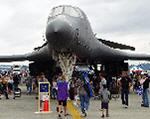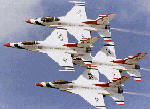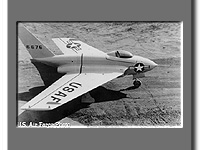
|
Description
| Manufacturer: | Northrop |
| |
| Base model: | X-4 | ||
| Designation: | X-4 | ||
| Designation System: | U.S. Air Force | ||
| Designation Period: | 1948-Present | ||
| Basic role: | Research | ||
| First Flew: | 1948/12/16 | ||
| See Also: | |||
Specifications
| Length: | 23' 3" | 7.0 m | |
| Height: | 14' 10" | 4.5 m | |
| Wingspan: | 26' 10" | 8.1 m | |
| Gross Weight: | 7,549 lb | 3,424 kg | |
| Max Weight: | 7,550 lb | 3,424 kg | |
Propulsion
| No. of Engines: | 2 | ||
| Powerplant: | Westinghouse XJ30-WE | ||
| Thrust (each): | 1,600 lb | 725 kg | |
Performance
| Cruise Speed: | 480 mph | 772 km/h | 417 kt |
| Max Speed: | 640 mph | 1,030 km/h | 556 kt |
| Ceiling: | 44,000 ft | 13,411 m | |
Examples of this type may be found at
| Museum | City | State |
| USAF Academy | USAF Academy | Colorado |
| United States Air Force Museum | Wright-Patterson | Ohio |
X-4 on display
United States Air Force Museum |
Recent comments by our visitors
| Guy E. Franklin Deatsville, AL | In the early days of transonic flight research, many aerodynamicists believed that eliminating conventional tail surfaces could reduce the problems created by shock wave interaction with the tail's lifting surfaces. To address this issue, the Army Air Forces's Air Technical Service awarded a contract to Northrop Aircraft Corporation on 5 April 1946 to build a piloted "flying laboratory." Northrop already had experience with tailless flying wing designs such as the N-1M, N-9M, XB-35, and YB-49. Subsequently, the manufacturer built two semi-tailless X-4 research aircraft, the first of which flew half a century ago.
The X-4 was designed to investigate transonic compressibility effects at speeds near Mach 0.85 to 0.88, slightly below the speed of sound. Northrop project engineer Arthur Lusk designed the aircraft with swept wings and a conventional fuselage that housed two turbojet engines. It had a vertical stabilizer, but no horizontal tail surfaces. It was one of the smallest X-planes ever built, and every bit of internal space was used for systems and instrumentation. The first X-4 arrived at Muroc Air Force Base by truck on 15 November 1948. Over the course of several weeks, engineers conducted static tests, and Northrop test pilot Charles Tucker made initial taxi runs. Although small of stature, he barely fit into the diminutive craft. Tucker, a veteran Northrop test pilot, had previously flown the XB-35 and YB-49 flying wing bomber prototypes. Prior to flying for Northrop, he had logged 400 hours in jet airplanes as a test pilot for Lockheed and the Air Force. He would now be responsible for completing the contractor phase of the X-4 flight test program. Finally, all was ready. Tucker climbed into the cockpit, and made the first flight on 15 December 1948. It only lasted 18 minutes, allowing just enough time for the pilot to become familiar with the basic handling qualities of the craft. The X-4 handled well, but Tucker noted some longitudinal instability at all speeds. Data generated during the initial flight led to design changes that improved handling and performance. While the first aircraft underwent modifications, the second X-4 arrived at Muroc in early 1949. Heavy rains flooded the dry lakebed at Muroc, delaying further flight testing until 27 April. The first X-4 made a few more flights, but was beset by mechanical problems. Soon, the second aircraft became the workhorse of the contractor test program. Its first flight was accomplished on 7 June 1949. It was more completely instrumented than its stablemate, and didn't suffer from the same plague of malfunctions. The National Advisory Committee for Aeronautics (NACA) expressed interest in using the second X-4 for research, but was frustrated by the slow pace of the contractor's test phase. Both X-4 aircraft were grounded temporarily for installation of spin recovery parachutes, and improvements to the landing gear uplock system. After these tasks were completed, the first X-4 made its tenth and final flight on 26 January 1950. It was grounded, and used as a source of spare parts for the second aircraft. On 17 February, the remaining X-4 completed the contractor testing phase. The aircraft was then turned over to the NACA and the Air Force for a joint research program. NACA technicians prepared the aircraft, and made a number of design improvements. The joint NACA/USAF program consisted of 82 flights to evaluate handling qualities, stability and control, and performance at various lift-to-drag ratios. NACA pilots during the program included Stanley Butchart, George Cooper, Scott Crossfield, John Griffith, Walter Jones, John "Jack" McKay, and Joe Walker. The Air Force pilots included B/Gen. Albert Boyd, Col. Frank "Pete" Everest, Lt. Col. Richard Johnson, Capt. J. S. Nash, and Maj. Charles "Chuck" Yeager. The final X-4 flight took place in September 1953. Further flights were planned, but a chronic fuel leak lead to cancellation of the program. NACA engineers had acquired a wealth of data, and the cost of repairing the leak could not be justified. Although the X-4 was never designed to fly at supersonic speeds, it gathered transonic data that proved that conventional tailless swept-wing configurations were unsuitable for supersonic performance. The design suffered from noticeable instability in all directions, increasing as it approached the speed of sound. It was, however, a valuable tool for dynamic stability research. Additionally low lift-to-drag data gathered with the X-4 was later beneficial to development of the X-15. On 10 March 1954, both X-4 aircraft were returned to the Air Force. The ejection seat from the second X-4 was retained by the NACA for use in the X-1E. The first X-4 is currently in storage at Edwards AFB. The second X-4 is on display at the Air Force Museum in Dayton, Ohio. 10/03/2006 @ 12:11 [ref: 14355] |
| j c elizabeth, CO | Although I have yet to visit the academy, I was fortunate enough to be involved in the restoration of your X-4's sister ship when it was in Hawthorne Calif at thw Western Museum of flight. Thanks for doing what you can to preserve our flight history. Hope to see you soon. 01/01/2001 @ 21:49 [ref: 1294] |
Recent photos uploaded by our visitors








